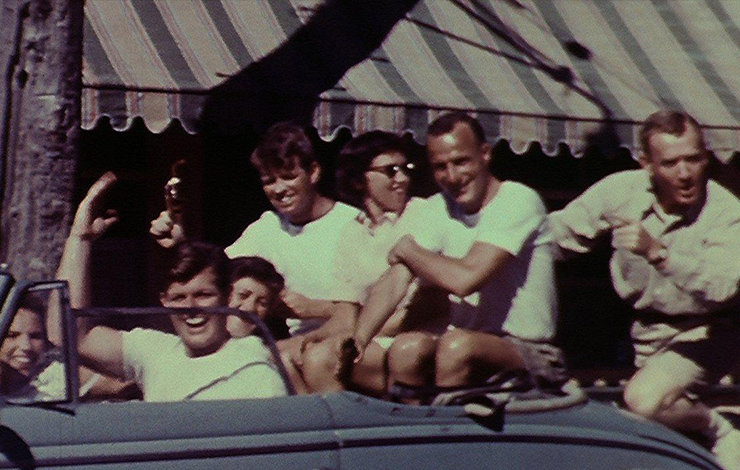
The Lost Kennedy Home Movies takes audiences on an intimate, behind-the-scenes journey from the 1930s into the early 1960s with members of one of the most influential families in the history of the United States. We meet Joe Kennedy, the father, who was the US Ambassador to England during the mid-to late 1930s; his wife, Rose; their family (including Jack, Bobby and Teddy); other siblings and friends; and Jacqueline, the wife of the future president.
The primary visual content is home movies taken in 16mm film format--including Kodachrome--mainly by family and friends, and still photographs. The images are augmented by a commentary narrated by Liev Schreiber and occasional cut-aways to historian Douglas Brinkley, Robert Dalleck, who authored the book Why England Slept, cable news commentator Chris Matthews and a few friends of the family.
The 90-minute documentary was produced and directed by Harrison Engle. It premiered on HISTORY last July.
"Stanley Moger is the visionary behind this documentary," Engle says. "Joe Kennedy knew his father, Art Moger, who was a publicist for Warner Bros. and a local celebrity on television and radio in Boston. Kennedy gave Art a 16mm reel of home movies and suggested there was a way to use it to help his son Jack's Senate campaign in Massachusetts."
The film sat in a box in the basement of the Moger house for years. The family subsequently donated it to the John F. Kennedy Library in Boston. Various people who knew the Kennedys also donated film to the library, which also includes thousands of still photos dating back to 1914.
Stanley Moger suggested to Engle that he consider weaving those images into the fabric of a documentary. They had originally crossed paths in 1986, when Engle produced, directed and edited The Indomitable Teddy Roosevelt. Engle and Moger visited the Kennedy Library in early 2009 for their first discussions with the archive managers. It was like a spark that started a fire.
"Within 10 minutes, we were all on the same track," Engle says. "They put me in touch with people who controlled the ownership of the Kennedy family films. It was clear that there was enough material for a meaningful film. We put the project into motion in December 2009."
Engle observes that people gravitated to John Kennedy. Various members of his family took pictures and home movies of and with him. Some of his colleagues always brought their film cameras when they visited with him and members of his family.
"I was fascinated by that initial reel, which nobody had seen since Art Moger put it in a cardboard box in the basement of his house 60 years ago," Engel says. "The reel had film shot by John, Ethel and Bobby Kennedy. You can feel the energy and vitality in all of them."
Engle estimates that he, Moger, script writer Paul Boorstin and editor Mark Petitils also read at least 50 books about John Kennedy and his family.
"They were all kind of books--positive, negative and in between," Engle says. "We also spoke with people at the Kennedy Library, interviewed four historians who had done significant research about the Kennedys, and talked to Paul Fay's daughter, Sally, and Cam Newberry's son, John. Cam Newberry was Jack Kennedy's classmate at Harvard. Paul Fay was Kennedy's shipmate when he captained a Navy PT boat for the Navy during the war.
"They stayed pals for a long time," Engle adds. "Paul always took his camera with him."
It took 17 months to make the film. Post-production was done at Laser Pacific in Los Angeles. Engle gave the Kennedy Library copies of the HD files.
"It was very special getting access to the original Kennedy family films," Engle says. "It is remarkable how durable that original film proved to be.
"The Kennedys are a storied family, but I am most impressed by their humanity, seeing them as kids and adults in relaxed settings, being playful," Engle observes. "I had seen many films about John Kennedy. We got to show another side, the informal family side of his life. I tried to stick to the story that the home movies led us to--or, to put it another way, we let the home movies be our guide and supplemented them where necessary to set the context straight. There are many things that were wonderfully visual in JFK's life, for example, his trip to Berlin during the Cold War."
Bob Fisher has written more than 2,500 articles about narrative and documentary filmmakers over the past 50 years. He has also written extensively about the importance of archiving yesterday and today's films for future generations.
